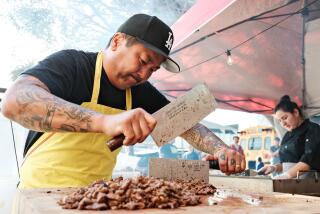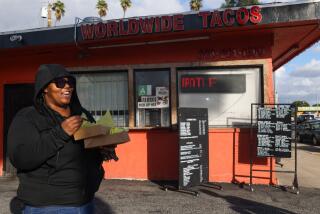A wrong turn for L.A.’s food truck scene?
Josh Hiller is fed up. As a partner in RoadStoves, the food truck outfitter that helped launch Kogi into the stratosphere, he thinks L.A.’s rapidly expanding new-wave food truck scene is getting out of hand.
“We tried to be very specific about the trucks we launched; we were looking for good business models and good food,” says Hiller of the months that followed Kogi’s launch 21/2 years ago and its unexpected success. At the time, Angelenos, united by Twitter, lined up for two hours or more to taste the truck’s signature Korean barbecue tacos.
“We got hundreds of calls, but we rejected 95% of the requests. The problem came when the other commissaries and truck owners saw money and basically just prostituted the whole culture. So what you ended up with was 15 so-so trucks parked on Mid-Wilshire, the city unhappy, a mediocre food product and all the truck owners cannibalizing each other’s business.”
Hiller is not alone in feeling that what was once an exciting, underground food scene driven by a punk rock aesthetic and an exploratory mentality is swiftly becoming a mainstream, bottom-line-obsessed maze of infighting and politics.
When Kogi started, there were only a few new-wave food trucks on the scene; now that number is hovering near 200, says Hiller. And where experimental entrepreneurs once dominated, corporate players such as Jack in the Box and Sizzler are entering the fray.
There are other issues too, including a wealth of copycat trucks and the sense that many entering the business have no culinary experience but expect to make a fortune.
That’s not to say that there isn’t a silver lining to the movement’s adolescence. Hiller, other truck owners and a ravenous public believe in the food truck’s promise — the realization of a street-food culture that unites a disparate city and encourages a community that lingers outdoors together over a plate of food. It’s a concept long understood by the loncheras, or taco trucks, that have operated for decades without stirring the beehive of debate that these flashy new trucks have generated.
Food trucks have also placed L.A. at the center of a national movement, with city councils, including those of Boston and Chicago, looking to L.A. to guide them through the issues presented by their own nascent food truck cultures, and television shows like “The Great Food Truck Race” capitalizing on the hype.
As other cities join the rolling party, those at the forefront of L.A.’s movement are evolving new business tactics to stay afloat in an increasingly saturated marketplace. Soon after Kogi’s success, co-owner and chef Roy Choi began selling his tacos at Alibi Room, and a year ago Choi’s team opened a small Westside restaurant called Chego. Now trucks including Frysmith, Komodo and Coolhaus are opening brick-and-mortar outlets themselves.
Even Hiller is moving his business in a new direction. He says RoadStoves is launching very few trucks until the scene self-corrects, and he’s creating an online store that will sell popular food truck items nationwide.
“Originally you could make a profit pretty quickly, but now you wouldn’t be profitable for a long time,” says Eric Tjahyadi, who co-founded the Komodo fusion truck with his brother Erwin a year and a half ago and recently opened a restaurant at Pico and Robertson boulevards. “There is so much saturation that we had to secure our future. Food truck leasing prices have gone way up since everybody is doing it. And it’s such a trend that you can’t just be a hot dog truck, you have to be an Indian hot dog truck to be unique.”
Hiller says that to launch a truck you’d need to spend at least $15,000, but you’d lose money for so long that you’d need $20,000 more to get to a point of survival. To have a truck custom-built can cost six figures.
Dave Danhi, the former Water Grill chef whose Grilled Cheese Truck has become a phenomenon on par with Kogi (recently generating a two-hour line at the Santa Anita Gourmet Food Truck Festival), says that getting into the black was no small feat even though he had 2,500 followers on Twitter before he had the keys to the truck in his hand.
“With all the regulations that are starting to crack down, it will be survival of the fittest,” says Danhi, on his way to make an appearance on the TV show “L.A. Ink,” where he was getting a tattoo of his truck’s logo as his “homage to fromage.” Danhi too plans to incorporate a traditional restaurant model into his business plans.
As do Natasha Case and Freya Estreller, the custom ice cream queens behind the Coolhaus truck, which launched in April 2009, making them, they say, “ancient.” The women already have three trucks in L.A. and two in Austin, Texas, and are in the process of rolling out two more in New York. When they open their brick-and-mortar location in Culver City this summer, it will employ a neat “inside-out” meta-twist that is sure to blow food truck followers’ minds: Their new store will be a truck parked inside the building.
“It’s natural selection,” says Estreller. “The variables of vending on the street are very tough — I see it as a way to market ourselves so we can book catering. For example, now we’re in Whole Foods, which I don’t think we would’ve have gotten into if we hadn’t been out there branding ourselves.”
Kogi’s Choi, the father of the scene, is amazed by the circus food trucks have generated and tries to distance himself from the politics. Sitting in front of Chego, wearing jeans with rolled cuffs and black sneakers, and sporting a tattoo of a heart with the initials L.A. and O.C. inside of it, Choi shows cellphone pictures of street vendors he met on a recent pilgrimage to Thailand. He believes that the trucks will thrive and grow only if people “get past the hype” and embrace the trucks culturally, like the people in his pictures.
“The thing about taco trucks that people don’t really understand is that it’s not about cheap eating,” he says. “Why do you think families bring their kids to eat on folding chairs? Not because it’s cheap but because it’s part of the culture. It’s only in America where it’s not considered a beautiful thing to be sitting outside with your family enjoying the weather. It’s only here where we have to sanitize everything.”
He says trucks need to stop congregating in the same lots and go out into L.A.’s vast outer reaches to feed neighborhoods “stacked with relatives,” such as Santa Fe Springs, Downey, La Puente, Hacienda Heights, Granada Hills, Northridge, El Segundo, Torrance, Reseda and Arleta.
If you “don’t serve and honor the culture and soul of L.A.’s neighborhoods, what differentiates you from that Marie Callender’s across the street that you are so blatantly fighting against?” asks Choi.
More to Read
Eat your way across L.A.
Get our weekly Tasting Notes newsletter for reviews, news and more.
You may occasionally receive promotional content from the Los Angeles Times.







